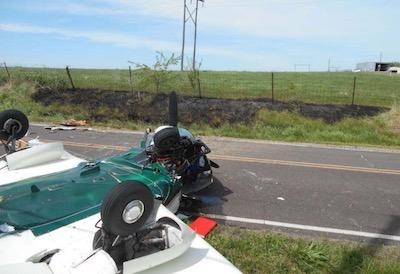Bellanca Viking Went Down On Approach To Jesse Viertel Memorial Airport In Boonville
The NTSB has released its probable cause report from an accident in Boonville, MO which fatally injured the pilot of the Bellanca Viking and a passenger on board the aircraft.

According to the report, on April 24, 2017, at 1339 central daylight time, the Bellanca 17-31-ATC airplane, N787TV, collided with high tension power lines and impacted terrain during final approach to land at the Jesse Viertel Memorial Airport (KVER). The airport manager at KVER reported that he had seen the pilot fly in and out of the airport on numerous occasions and that the pilot often flew a low final approach. On the day of the accident, he saw the airplane very low on final approach for runway 18. As the airplane continued toward the airport, it collided with power lines about 0.5 mile north of the runway's approach end. Weather conditions at the time of the accident included a clear sky with no obstructions to visibility. Examination of the airframe and engine did not reveal any anomalies that would have contributed to the accident. The pilot was familiar with the airport and was likely aware of the location of the power lines, which were well below a normal glideslope to the runway.
The pilot did not hold a medical certificate. An autopsy of the pilot revealed coronary artery disease and significant brain pathology. It is unlikely that the pilot's coronary artery disease contributed to the accident as it would not have impaired the pilot's judgment, vision, or decision-making. The pilot had scarring from a previous brain injury and severe damage to his left optic nerve to the extent that he was nearly blind in that eye. Given that the pilot failed to maintain proper altitude while operating in visual conditions and struck a potentially visible hazard, it is likely that his vision deficiency contributed to the accident.
Toxicology test results indicated that the pilot had used multiple psychoactive drugs before the accident, including cocaine, methamphetamine, clonazepam, and diphenhydramine. In addition to their psychoactive effects, these drugs are potent vasoconstrictors and can cause small arteries to spasm, cutting off blood flow to portions of vital organs. Although the neuropathologist who examined the pilot's brain believed the degree of cerebral hypoxic/ischemic damage he identified would take several hours to develop, the pilot was deceased by the time first responders arrived about 10 minutes after the witnessed crash. Therefore, this hypoxic/ischemic damage had to have begun before the accident and was likely caused by the pilot's misuse of cocaine and methamphetamine. This evolving brain ischemia may have played a role in the circumstances of the accident, but without specific information regarding the pilot's symptoms, its exact role cannot be determined. Although the pilot's stage of intoxication with
methamphetamine or cocaine at the time of the accident is unknown, it is very likely that he was impaired by the combined effects of these drugs.
The National Transportation Safety Board determined that the probable cause(s) of this accident was te pilot's impairment, due to his use of a combination of psychoactive drugs and a vision deficiency in his left eye, which resulted in a failure to maintain adequate altitude during final approach to landing and subsequent collision with power lines.
(Image provided by the Missouri State Highway Patrol)
 ANN's Daily Aero-Term (04.25.24): Airport Rotating Beacon
ANN's Daily Aero-Term (04.25.24): Airport Rotating Beacon ANN's Daily Aero-Linx (04.25.24)
ANN's Daily Aero-Linx (04.25.24) Klyde Morris (04.22.24)
Klyde Morris (04.22.24) Airborne 04.24.24: INTEGRAL E, Elixir USA, M700 RVSM
Airborne 04.24.24: INTEGRAL E, Elixir USA, M700 RVSM Airborne 04.22.24: Rotor X Worsens, Airport Fees 4 FNB?, USMC Drone Pilot
Airborne 04.22.24: Rotor X Worsens, Airport Fees 4 FNB?, USMC Drone Pilot



